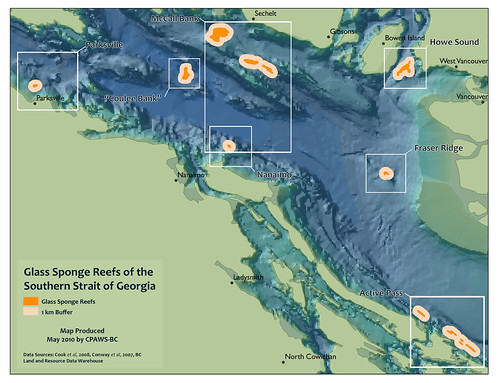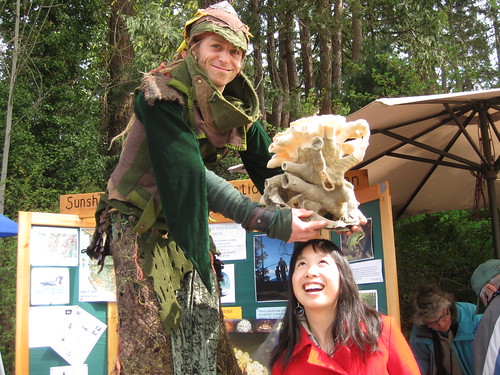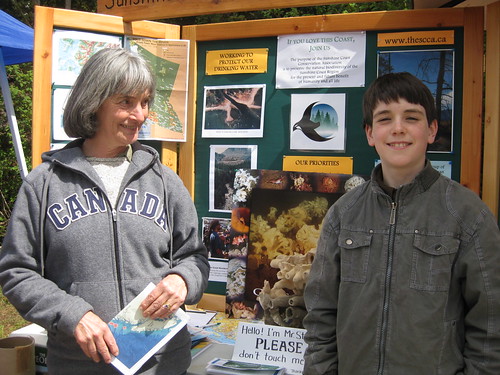Protecting prehistoric sponge is not as easy as a taking a luxurious sponge bath but I guarantee seeing it protected for future generations will give you that same glowing feel good feeling.
The Canadian Parks and Wilderness Society (CPAWS) have been working for years to protect a sponge once thought to have disappeared with the dinosaurs but found alive and well right here in British Columbia.
The group is calling for protection of all these glass sponge reefs located through out the southern Strait of Georgia, after successfully gaining some recognition towards protection in Hecate Strait in the Queen Charlotte Islands on World Oceans Day.
Gail Shea, Minister of Fisheries and Oceans, has declared an “Area of Interest” for a future Marine Protected Area around the reefs, considered one of the great wonders in Canada’s oceans.
Can the coral in the Strait of Georgia be protected too? Should we be protecting the marine floor? I think yes. It is as critical to our planet as the forests and air. So why do so many of us still make a business out of destroying it?
I have worried for at least 3 decades now about the constant pounding the Strait of Georgia takes from pollution run off. The basin is like a giant cauldron, so anything and everything we can do to safeguard its health is critical. It also takes a blood bath in plastic pollution.
Check out this story It's A Whale of a Plastic Picnic where I show photos of two fist fulls of plastic I picked up off the beach and a video of the whale that's been hanging out in the filth, rumoured to have had a baby calf. I envision feeding a bucket of plastic to the whales open mouth.
http://duaneburnett.blogspot.com/2010/07/its-whale-of-plastic-picnic.html
Ok stay with me here.... back on topic! LOL
I hope you will agree and help get the word out there. These days its as easy as clicking "Like" and all your facebook friends instantly know about it!

The issue came to my attention today, when a volunteer from the Sunshine Coast Conservation Association (SCCA) asked me to sign a petition outside the Daily Roast in Sechelt, BC.
I went home and Googled it only to find myself more confused. The article said protection was forthcoming so why were they passing a petition around to protect them?
http://www.cpawsbc.org/campaigns/marine/glassspongereefs.php
I contacted CPAWS and asked them to help me out.
Veronica Lo, Marine Conservation Planning Coordinator for the Canadian Parks and Wilderness Society - BC Chapter emailed to say:
It’s easy to understand the confusion – there are two separate geographical groupings of sponges, and the ones that DFO have announced as an Area of Interest as a potential Marine Protected Area are the northern group, located in Hecate Strait. That was great news on Oceans Day!
However, there is another group of glass sponge reefs located in the Southern Strait of Georgia – these have not been afforded any protection. While smaller, they also rare and unique, and provide habitat for a multitude of marine organisms. The SCCA are our partners in trying to achieve protection of these southern sponge reefs, through fishing closures, and eventually permanent protection as a Marine Protected Area.

And what a tremendous help and wealth of information. I don't think I can say it any better then to share with you the information Veronica passed along.
GLASS SPONGE REEFS OF BRITISH COLUMBIA: BACKGROUNDER
For the past decade, CPAWS-BC has been working to protect the globally unique glass sponge reefs in British Columbia. Glass sponge reefs were first discovered on the coast of British Columbia in 1988, in Hecate Strait. Smaller glass sponge reefs have more recently been discovered in the Southern Strait of Georgia. Thought to have been extinct for 30 million years, they are the only known living glass sponge reefs anywhere on Earth. The sponge reefs are composed entirely of silica, hence the name “glass” and are extremely fragile. They have been growing on the seafloor at depths of 200 metres since the last glaciers retreated over 9,000 years ago. The four sizeable sponge reefs in Hecate Strait reach heights comparable to an eight-storey building (approximately 25 metres) and span about 1000 square kilometres. Since their discovery, numerous newspapers and magazines have featured these special marine organisms.
Sponge Reefs at Risk
The glass sponge reefs are not only significant because of their rarity, but they also provide vital habitat to a wide range of marine animals including octopi, shrimp, squat lobsters, sea cucumbers and fish including rockfish, ling cod, skate and sole. Unfortunately, these glass sponge reefs are very fragile and, like corals, have very slow growth rates. Studies have shown that approximately half of the sponge reefs have been damaged by bottom-contact fishing (trawling). As a result of efforts by CPAWS-BC, Fisheries and Oceans Canada instituted fishing closures for the northern reefs in 2004.
Marine Protection – A Solution
In recognition of the rarity of the glass sponge reefs, CPAWS-BC applied for UNESCO World Heritage Site designation for the Hecate Strait sponge reefs. The application was denied, as in order to be granted this special status, the sponge reefs need to be permanently protected by the federal government.
CPAWS-BC has worked extensively with sponge researcher Dr. Manfred Krautter from Leibniz University in Germany to spread awareness of these incredible organisms to the public. CPAWS-BC and Dr. Krautter conducted a speaking tour to costal communities in B.C. including Sechelt, Tofino, and Parksville. The tour included a presentation to the Standing Committee on Fisheries and Oceans about the urgent need for long term protection with MPs and DFO staff, and meetings with the Deputy and Assistant Deputy Ministers.
Over the years, many local politicians have written to the Minister of Fisheries and Oceans to voice their support for marine protected areas around the glass sponge reefs. The Association of Vancouver Island and Coastal Communities, and the Union of BC Municipalities have endorsed permanent protection of the sponge reefs in ‘The Glass Sponge Reefs of BC Resolution B171’.
Not only have the sponge reefs struck a chord with the wider community, they have also fascinated scientists. In 2008, CPAWS-BC co-hosted a Glass Sponge Reef Symposium in Sidney, B.C., with Natural Resources Canada, to facilitate collaborative research on sponge reefs between various academic institutions. Natural Resources Canada has been an important partner in prioritizing research around the glass sponge reefs.
In addition to establishing MPAs and interim protection measures for specific areas, CPAWS-BC actively promoted a coast-wide strategy for glass sponge reef protection. CPAWS co-hosted a Coral and Sponge Conservation Strategy Workshop with Fisheries and Oceans Canada to gather scientists and managers in discussions about an overall conservation strategy for sponges and corals in B.C.
The consideration of the glass sponge reefs in Hecate Strait as MPAs is an important step toward the long-term protection of reefs. CPAWS will continue to work with Fisheries and Oceans Canada and other stakeholders to complete the designation process within the 2012 timeline promised by the government.

Earth Day, Roberts Creek, BC, photos Veronica Lo.
I think about the tragedy of the Great Barrier Reef in Australia and how we are loosing coral reefs around the world. I sure hope we can protect what he have in our own back yard!
Below is some information about the organization and links to find out more.
Again, thank you for reading my blog, all your great comments, feed back and story suggestions. Don't forget to share them around, they are doing absolutely no good sitting here on my blog all by themselves. Duane
CPAWS likes it wild. As Canada's grassroots voice for wilderness, over the years, the Canadian Parks and Wilderness Society, CPAWS, has helped to protect over 400,000 square kilometres of threatened areas. CPAWS-BC is one of 13 chapters across Canada and plays a key role in establishing new protected areas and in improving the management of existing parks.
We achieve our goals through advocacy, education and cooperative partnerships with other environmental groups, industry, governments, First Nations and the public.

Want to help save these stunning sponges, some located right off of Sechelt, BC?
Its free to write Gail Shea the Minister of Fisheries and requires no stamp!
The Honourable Gail Shea
Minister of Fisheries and Oceans
House of Commons
Ottawa, Ontario
K1A 0A6
LINKS
CPAW Website
http://www.cpawsbc.org
Facebook page
http://www.facebook.com/pages/CPAWS-BC/105343002836565?ref=ts
http://twitter.com/CPAWSbc
Sunshine Coast Conservation Association
http://www.thescca.ca/
Gail Shea, Minister of Fisheries and Oceans
http://www.gailshea.ca/EN/4741/
Sponge http://en.wikipedia.org/wiki/Sponge
Coral http://en.wikipedia.org/wiki/Coral
Hectate Strait http://en.wikipedia.org/wiki/Hectate_strait
Georgia Strait http://en.wikipedia.org/wiki/Georgia_Strait

It's Always A Good Day on the Sunshine Coast!
Hope you liked! Come and Join me on facebook or twitter! Duane
http://duaneburnett.com
http://duaneburnett.blogspot.com
http://twitter.com/duaneburnett
Duane's Facebook Profile
http://www.facebook.com/profile.php?id=570266071
Duane's Facebook Fan Page
http://www.facebook.com/pages/Duane-Burnett/132243609016?ref=ts
Sunshine Coast BC Canada facebook FAN PAGE
http://www.facebook.com/pages/Sunshine-Coast-BC-Canada/109315035764459

Great article Duane. Thanks for the support in our efforts to protect these ancient life forms just off our Sechelt shore. Pretty small downside in protecting this area but a great loss if we continue to have them ripped of the sea floor. Apparently one recently came into Gibson's harbour on the deck of a ship after being inadvertently dragged from the bottom. Such a shame.
ReplyDeleteKeep up the good work.
Thanks Jason, appreciate your kind comments. The ocean floor is as important as any forest and its health is vital to life on Earth.
ReplyDelete